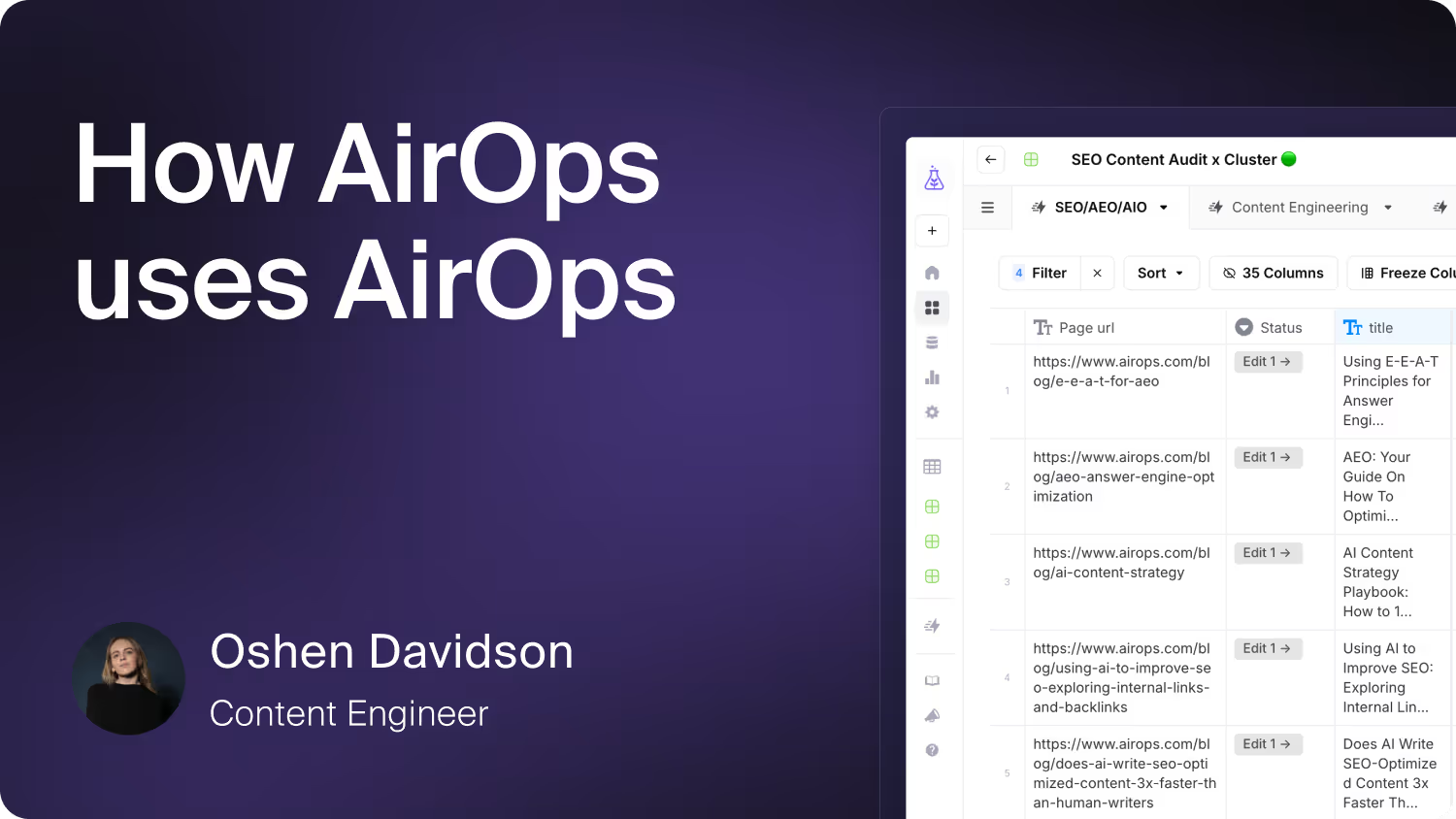What is an AI Workflow?

AI workflows are essential for businesses looking to integrate artificial intelligence into their operations. They define the structured process through which AI systems are developed, deployed, and maintained to solve business problems efficiently.
Each step in an AI workflow, from data collection and preparation to model building and evaluation, plays a critical role in ensuring that AI applications perform effectively at scale. With the right workflow in place, businesses can automate decision-making, improve operational efficiency, and gain valuable insights from their data.
As AI becomes more embedded in various industries, understanding how to design and manage these workflows is crucial for companies aiming to stay ahead in a highly competitive environment. In this article, we’ll go over the key stages of AI workflows and why they are crucial to getting the most out of your AI solutions.
What is an AI Workflow?
An AI workflow is the process of organizing and managing the tasks involved in building, deploying, and maintaining AI models. It typically begins with identifying a business problem and gathering relevant data. This data is then processed and cleaned to ensure it's ready for use in training AI models.
The next step involves selecting, developing, and training the AI model to perform a specific task, such as making predictions or automating a decision process. After the model is built, it is tested for accuracy and deployed into production.
Continuous monitoring and updates are part of the workflow to maintain performance and ensure that the AI model adapts to new data or changes in business requirements. This structured approach allows businesses to use AI efficiently, improve processes, and make data-driven decisions.
Types of AI Workflows
AI workflows come in various forms, each designed to tackle specific tasks and challenges. Understanding the different types of automated workflows can help you choose the right one for your needs.
Rule-Based AI Workflows
Rule-based AI workflows follow a set of predefined rules and logic to automate repetitive tasks. These workflows are ideal for straightforward processes that don't require complex decision-making or adaptability.
For example, a rule-based AI workflow could be used to automatically categorize and route customer support tickets based on predefined criteria, such as the type of issue or the customer's priority level.
Intelligent AI Workflows
Intelligent AI workflows take automation to the next level by using machine learning algorithms to adapt and improve over time. These workflows analyze data inputs and outcomes to identify patterns and optimize their performance.
An intelligent AI workflow for content creation might learn from user engagement data to recommend topics, optimize headlines, and refine writing style for maximum impact. As more data is collected, the workflow becomes increasingly effective at delivering targeted, engaging content.
Generative AI Workflows
Generative AI workflows use artificial intelligence to create entirely new content, designs, or solutions based on learned patterns and user input. These workflows are particularly useful for creative tasks that require innovation and originality.
In the content creation industry, generative AI workflows can produce unique articles, images, and even videos tailored to specific audiences and objectives. However, it's important to ensure that the content created by these workflows is not easily detectable as AI-generated. Making your AI-generated content indistinguishable from human-written content is key to maintaining credibility and engagement with your audience. While there’s nothing unethical about using AI for content creation, we’re still in the early ages of the adaptation of AI, where a large part of the industry still considers its usage somewhat immoral.
Benefits of AI Workflows
Implementing AI workflow automations can yield significant benefits for your organization, from boosting efficiency to reducing costs and improving quality. Here are some ways AI is going to positively impact your day-to-day processes.
Increased Efficiency
AI-powered workflows automate repetitive tasks, allowing you to complete them faster and more accurately than manual processes. By delegating these time-consuming activities to AI, you can focus on higher-value work that requires human creativity and strategic thinking. This increased efficiency translates into quicker turnaround times, enhanced productivity, and the ability to scale your operations without adding more staff.
Cost Savings
Automating tasks with AI can significantly reduce labor costs associated with manual processes. AI workflows can handle a high volume of tasks without the need for additional human resources, resulting in substantial cost savings over time. In fact, some organizations have cut content creation costs by 90% by leveraging AI-powered content generation.
Improved Quality
AI-driven workflows ensure consistency and reduce human error by following predefined rules and learning from past data. This is particularly valuable in content creation, where maintaining a consistent brand voice and style across all channels is essential. AI can also optimize content for specific audiences and objectives, improving engagement and conversions.
Enhanced Insights
AI workflows analyze vast amounts of data to provide valuable insights that inform decision-making. By identifying patterns and trends, AI can help you make data-driven decisions about content strategy, audience targeting, and more. With AI tools like AirOps, you have the option to use first-party data and integrate it with third-party signals to guarantee that you’re incorporating all available factors in your decision-making process.These insights can give you a competitive edge and help you stay ahead of the curve in your industry.
How Do AI Workflows Work?
various processes. Here's a broad overview of the main stages typically involved in an AI workflow.
- Data Collection and Preparation. The process starts with gathering data from multiple sources, which can include both structured data (like databases) and unstructured data (such as text or images). After collecting data, it's cleaned, processed, and transformed to ensure quality and consistency before being used in the model.
- Model Development. With prepared data, a suitable machine learning model is either selected or developed. The model is then trained to recognize patterns or make predictions based on the provided data.
- Evaluation and Tuning. Once the model is trained, its performance is evaluated using various metrics. If necessary, adjustments or fine-tuning are made to improve its accuracy and effectiveness.
- Deployment and Monitoring After evaluation, the model is deployed into a real-world environment where it automates tasks or makes predictions. Ongoing monitoring ensures the model continues to meet performance expectations, with updates as needed.
We’ll talk about the actual tech in more detail later on.
How Can AI Workflows Improve Content Marketing?
AI workflows can revolutionize your content marketing efforts in several key areas. From content creation to distribution and optimization, AI-powered solutions streamline operations and deliver better results.
Automated Content Creation and Enhanced SEO
Search engine algorithms are structured sets of rules designed to rank content based on various factors, including relevance, quality, and user engagement. AI, however, doesn’t just follow these rules—it analyzes them to help businesses optimize their content strategy. By studying competitors' top-ranking content, AI can identify what is working and provide actionable insights to create content that performs better. This allows businesses to meet search engine criteria while also crafting material that resonates with audiences, ensuring both higher rankings and user satisfaction.
AirOps offers robust tools for content creation, optimization, and strategy. With AI-driven solutions, businesses can generate human-like content that ranks well on search engines, all while maintaining brand voice and consistency. AirOps helps streamline the content workflow by automating keyword research and providing real-time data analysis, ensuring that your content is not only SEO-optimized but also aligned with what your audience is searching for.
Additionally, it enhances existing content by integrating technical SEO optimizations, such as smart linking and schema markup, to improve rankings. AirOps also aids in content strategy, uncovering high-potential keywords and content opportunities that competitors may have overlooked.
If you're looking to improve your content creation and SEO processes with scalable, AI-powered solutions, schedule a demo with AirOps to see how it can fit into your strategy.
Optimized Content Distribution
Effective content distribution is essential for reaching your target audience and maximizing the impact of your content. AI workflows can analyze audience data, such as demographics, interests, and behavior patterns, to determine the best channels and times for promoting your content. By leveraging AI insights, you can ensure that your content reaches the right people at the right time, increasing engagement and conversions. For example, AI-optimized product pages can increase conversions by 18% .
Personalized Content Experiences
In today's digital landscape, consumers expect personalized experiences tailored to their unique needs and preferences. According to McKinsey, companies that excel at personalization generate 40% more revenue from those activities than average players.
AI workflows can help you deliver these experiences by analyzing individual user behavior and preferences to recommend relevant content. By serving up content that resonates with each user, you can foster deeper engagement, build stronger relationships, and increase customer loyalty.
How to Implement an AI Workflow for Content Creation
Implementing an AI workflow for content creation can seem daunting, but with the right approach, you can streamline your processes and achieve impressive results. Here's a step-by-step guide to help you get started.
Step 1: Define Your Goals
Before diving into AI-powered content creation, take the time to identify the specific tasks you want to automate and the outcomes you hope to achieve. Do you want to generate more blog post ideas? Improve the quality of your content? Increase your publishing frequency? Having clear goals will help you choose the right AI tools and measure your success.
Step 2: Choose the Right AI Tools
Once you've defined your goals, research and select AI tools that align with your needs and integrate seamlessly with your existing systems. Look for tools that offer the specific features and capabilities you require, such as natural language processing, content optimization, or automated publishing. Consider factors like ease of use, scalability, and customer support when making your decision.
With AirOps' customizable workflows, you can automate your most ambitious growth strategies while maintaining full control. Combining over 40 AI models and seamless integrations, AirOps lets you turn complex ideas into executable workflows that streamline content creation, market analysis, and SEO optimizations. Through a simple drag-and-drop interface, you can build precise AI workflows, automate repetitive tasks, and even incorporate domain-specific knowledge for more accurate outcomes.
Step 3: Train the AI
To get the most out of your AI workflow, you'll need to feed the system with relevant data and train it to perform the desired tasks. This may involve providing the AI with examples of high-performing content, setting up keyword and topic preferences, or defining your brand voice and style guidelines. In some cases, you may also want to review, validate, and edit AI-generated text before continuing the workflow, ensuring it meets your standards. The more data you provide, the better the AI will understand your needs and deliver accurate, on-brand results.
Step 4: Test and Refine
As with any new process, it's important to monitor the AI's performance closely and gather feedback from your team and audience. Keep an eye on metrics like engagement, conversions, and search rankings to gauge the effectiveness of your AI-generated content. Use this feedback to make adjustments and fine-tune your workflow over time. Remember, AI is a powerful tool, but it still requires human oversight and input to achieve the best results.
Step 5: Scale and Optimize
Once your AI workflow is running smoothly and delivering the desired results, look for opportunities to scale and further optimize the process. This may involve expanding your content production to new channels or formats, experimenting with different AI tools or features, or boosting organic traffic by 20x in 2 months as some companies have achieved. Keep pushing the boundaries of what's possible with AI-powered content creation, and you'll stay ahead of the curve in an increasingly competitive digital landscape.
Implementing an AI workflow for content creation requires careful planning, the right tools, and a willingness to experiment and adapt. By following these steps and staying focused on your goals, you can harness the power of AI to create compelling, high-performing content at scale.
If you’re more of a visual learner and can’t seem to understand how to create an AI workflow with AirOps, we’ve covered how to use our workflow builder in detail on the AirOps Academy.
Final Thoughts - What Should an AI Workflow Tool for Content Marketing Include?
AI workflows simplify content creation and optimization, ensuring that businesses can deliver high-quality, SEO-optimized content more efficiently. By automating repetitive tasks and integrating smart decision-making models, AI workflows help content teams stay competitive and agile in an increasingly data-driven landscape.
For an AI workflow tool to truly enhance content marketing, it should include several key features. Brand Kits allow for consistent content creation that aligns with your brand’s voice, ensuring that every piece of content remains authentic. Knowledge Bases help the AI adapt to your specific industry knowledge and expertise, improving the accuracy and relevance of your content. Robust API and Integration Options ensure that the tool can connect seamlessly with your existing platforms, making it easier to manage workflows across different systems.
AirOps stands out as the best solution for managing AI workflows in content marketing. With customizable workflows, seamless integrations, and tools designed to enhance content production at scale, AirOps offers everything you need to optimize your content strategy and drive growth. If you're looking for an AI workflow tool that delivers results without sacrificing quality or control, AirOps is the ideal choice.
Sign up with AirOps and start optimizing your processes with AI workflows today.
Win AI Search.
Increase brand visibility across AI search and Google with the only platform taking you from insights to action.
Get the latest on AI content & marketing
Get the latest in growth and AI workflows delivered to your inbox each week
.avif)





